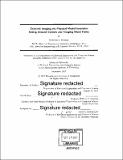Extreme imaging via physical model inversion : seeing around corners and imaging black holes
Author(s)
Bouman, Katherine L. (Katherine Louise)
DownloadFull printable version (33.43Mb)
Other Contributors
Massachusetts Institute of Technology. Department of Electrical Engineering and Computer Science.
Advisor
William T. Freeman.
Terms of use
Metadata
Show full item recordAbstract
Imaging often plays a critical role in advancing fundamental science. However, as science continues to push the boundaries of knowledge, imaging systems are reaching the limits of what can be measured using traditional-direct approaches. By designing systems that tightly integrate novel sensor and algorithm design, it may be possible to develop imaging systems that exceed fundamental theoretical limitations to observe things previously impossible to see. However, these non-traditional imaging systems generally come with a trade-off; they produce increasingly sparse and/or noisy measurements that require incorporating additional structure to extract anything meaningful. The focus of this thesis is on using computational methods that exploit structure in our universe to move past these obstacles and reveal the invisible. In this thesis, we focus on two imaging problems that explicitly leverage structure in our universe: reconstructing images and video from a computational telescope the size of the Earth, and seeing around corners. For the first imaging problem, this thesis investigates ways to reconstruct images and video from a sparse telescope array distributed around the globe. Additionally, it presents a number of evaluation techniques developed to rigorously evaluate imaging methods in order to establish confidence in reconstructions done with real scientific data. The methods and evaluation techniques developed in this thesis will hopefully aid in ongoing work to take the first picture of a black hole. Next, this thesis presents methods developed for using the subtle spatio-temporal radiance variations that arise on the ground at the base of an edge to construct a one-dimensional video of a hidden scene. These methods may be especially valuable in remotely sensing occupants in a room during search and rescue operations, or in detecting hidden, oncoming vehicles and/or pedestrians for collision avoidance systems.
Description
Thesis: Ph. D., Massachusetts Institute of Technology, Department of Electrical Engineering and Computer Science, 2017. Cataloged from PDF version of thesis. Includes bibliographical references (pages 235-249).
Date issued
2017Department
Massachusetts Institute of Technology. Department of Electrical Engineering and Computer SciencePublisher
Massachusetts Institute of Technology
Keywords
Electrical Engineering and Computer Science.